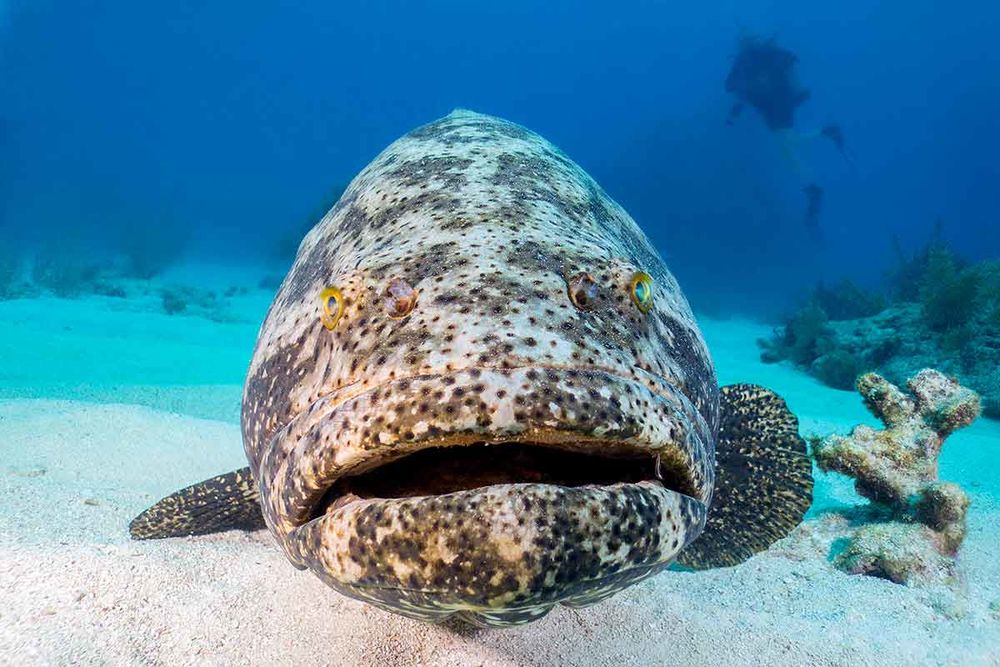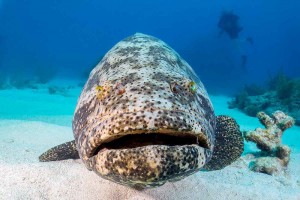Goliath grouper are at the center of a debate raging in Florida. Fishermen say they are a nuisance. Divers say they are great for tourism. Some scientists say they haven’t recovered from decades of overfishing. Meanwhile, the Florida Fish & Wildlife Conservation Commission is considering a limited open-fishery on the gentle giants. What’s going on?
The goliath grouper, true to its name, is the largest of the Atlantic groupers. A massive, slow-moving fish, it’s been known to reach up to 8 feet in length and weigh up to 800 pounds.
Its massive size and slow growth (it takes five to seven years for a grouper to become sexually mature) has made it highly susceptible to pressure from commercial and recreational fishing, which has led to its status as an endangered species by the International Union for the Conservation of Nature.
Recently, the FWC conducted a stock assessment of the grouper’s numbers in Florida, and found it to be at much healthier levels than it was when first declared an endangered species. However, the study was rejected for use in federal waters by an independent panel of scientists due to its limited scope, which only included South Florida.
Now the grouper could be hunted again as soon as next year.
Since 1990, it has been illegal to capture or kill the goliath in federal and state waters. However, for several years, fishermen in Florida have contested that the grouper are back, and are eating much of their catch.
They’ve raised enough concern that the FWC is now considering reopening the fishery, albeit in a limited fashion. Due to the controversy around the issue, the FWC is hosting more than a dozen workshops to discuss the matter and to get a feel for public opinion. Currently, one idea on the table is to create a four-year paid lottery that would allow 100 people each year to harvest one goliath grouper. It would cost $300 to buy into, and the fish can only be caught by hook and line, with no commercial harvest or sale allowed. The community workshops will refine this idea, or see if it will indeed work at all.
Not everyone thinks reopening the fishery is a good idea. Scientists are skeptical that the goliath grouper has recovered enough to allow it to be killed, even in a limited fashion. Studies by Florida State University marine biologists in 2010 and 2011 found that the grouper is still being fished illegally and disagreed with anglers’ statements that the goliath is a threat to their livelihood. The authors of both papers say that the grouper’s diet consists of calico crabs, invertebrates and slow-moving fish, not game fish. Furthermore, they found that goliaths improve reef diversity rather than threaten it, countering a claim that has been made by proponents of an open fishery.
Meanwhile, diving organizations such as DEMA stress that the goliath grouper is good for the dive business in Florida, attracting divers and tourists who wish to see the giant, slow-moving fish for themselves.
Some supporters of reopening the fishery say that catching goliath grouper will provide more insight into its biology, a point which has been rejected by marine biologists, who say that it isn’t necessary to kill the grouper to study them.
Regardless, anglers contend that they are competing with the grouper, saying that goliaths have snatched their catch from their lines as they were reeling them in.
By hosting the public workshops, the FWC hopes to bring all these different voices together. If a decision is made to have a limited open fishery, they say it likely wouldn’t go into effect until 2018.
The schedule of workshops can be seen here. Those who can’t make the open workshops can leave a comment on the website.
Source: Sport Diver








